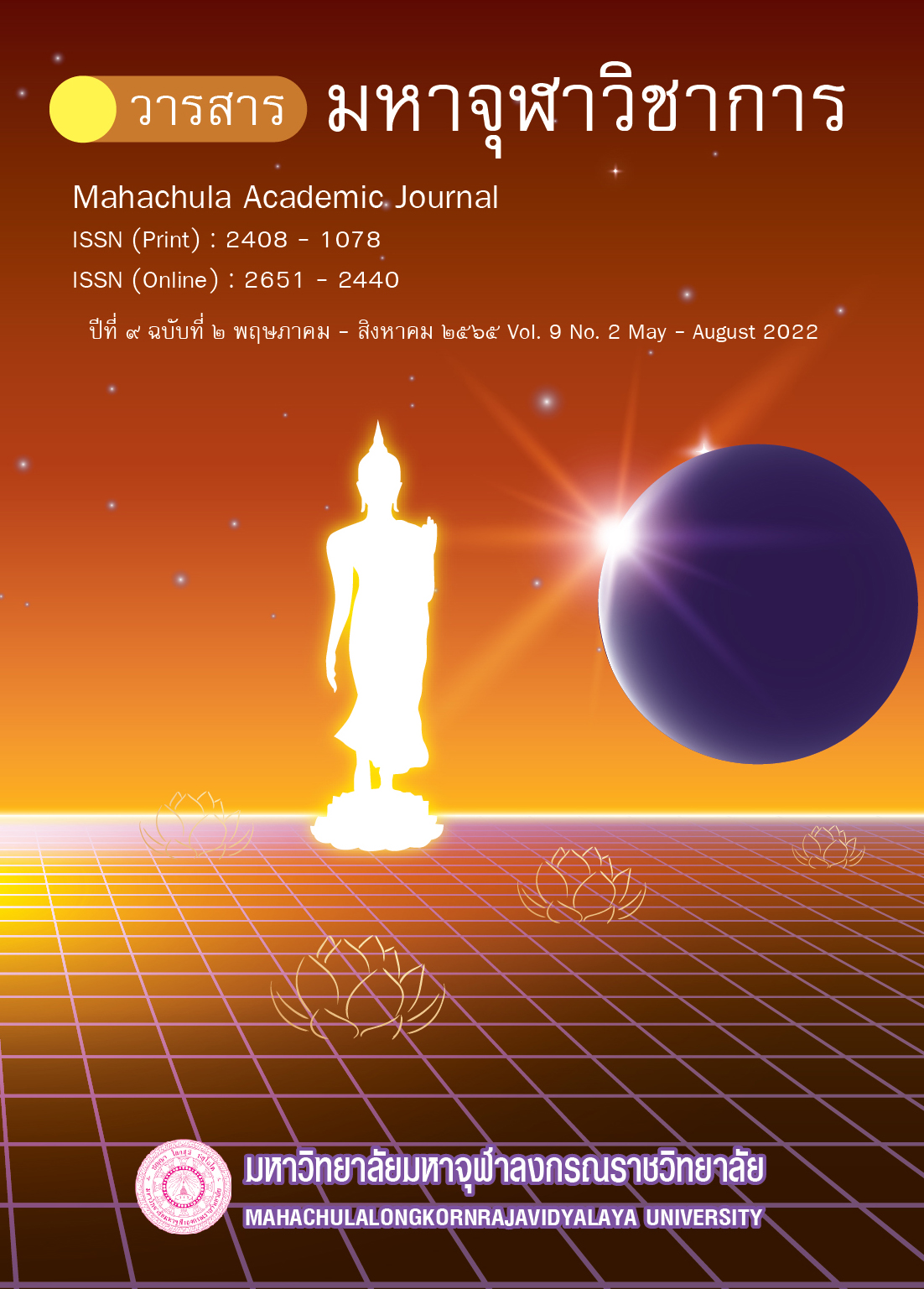Faith and Wisdom: Pilgrims to Four Holy Buddhist Places in India and Nepal
Main Article Content
Abstract
This academic article “Faith and Wisdom: Pilgrims to Four Holy Buddhist Places in India and Nepal” aims at (1) To study the level of Faith and Wisdom of Pilgrims to Four Holy Buddhist Places in India and Nepal. (2) To study Faith and Wisdom in the Buddhism (3) To study the right way of Pilgrims to Four Holy Buddhist Places in India and Nepal. Thai Buddhists’ pilgrimage in 4 holy places are traveling with faithfulness and motivation in The Lord Buddha in order to pay respect to the birth place, the enlightenment, the first sermon and the pass away (Nirvana) site of Buddha which are the crucial places in Tripitaka according to Buddha’s speech for the results of three recognitions compose of Buddha’s Recognition, Dhamma’s recognition and Sangha’s Recognition.
Faith and Wisdom plays an important role in Buddhist teaching, and it makes Buddhism outstanding from other religions. Moreover, faith leads to wisdom which is more inevitable and well grounded. Right faith is developed from correct knowledge & understanding. Then, one has correct belief leading to more of wisdom . Likewise, faith relies on two main factors namely (i) knowledge and (ii) belief. When we perceive any knowledge either right or wrong and we believe in someone or something based on such knowledge, it can be either a belief or misbelief. When faith is negative, we call it “credulity.”
Therefore, Right faith and Wisdom of Pilgrims is important to the virtue results of pilgrimage in 4 holy places. Firstly, for human value as to develop of mindfulness in life. Secondly, for social value as to develop of an enhancing quality of Thai Buddhists and expanding the Dhamma for the last long Buddhism. Lastly, for individual value as a beneficially values in enhancing quality of life and fulfill the good pilgrim through the path of The Lord Buddha’s pure Dhamma which will lead to peace and Nirvana.
Article Details

This work is licensed under a Creative Commons Attribution-NonCommercial-NoDerivatives 4.0 International License.
References
ชญาน์นันท์ อัศวธรรมานนท์. “วิเคราะห์คุณค่าเชิงพุทธจริยศาสตร์ในการจาริกแสวงบุญ จตุสังเวชนียสถานของชาวพุทธไทย”. วิทยานิพนธ์พุทธศาสตรดุษฎีบัณฑิต. บัณฑิตวิทยาลัย: มหาวิทยาลัยจุฬาลงกรณราชวิทยาลัย, ๒๕๕๖.
นิดา เหล่าฤกษ์อุทัย. แรงจูงใจของชาวพุทธไทย ต่อการจาริกแสวงบุญ ณ สังเวชนียสถาน ๔ ตำบล. วิทยานิพนธ์พุทธศาสตรมหาบัณฑิต. บัณฑิตวิทยาลัย. มหาวิทยาลัยจุฬาลงกรณราชวิทยาลัย, ๒๕๕๘.
ประเวศ วะสี. ๙๔ ชีวิตท่องพุทธภูมิ. พิมพ์ครั้งที่ ๒. กรุงเทพมหานคร: สํานักพิมพ์หมอชาวบ้าน, ๒๕๕๘.
พระธรรมปิฎก (ป.อ. ปยุตฺโต). พจนานุกรมพุทธศาสตร์ฉบับประชาชน. พิมพ์ครั้งที่ ๑๑. มหาจุฬาลงกรณราชวิทยาลัย, ๒๕๔๖.
พระพรหมคุณาภรณ์ (ป.อ. ปยุตฺโต). พจนานุกรมพุทธศาสน์ฉบับประมวลศัพท์ พิมพ์ครั้งที่ ๒๓. กรุงเทพมหานคร: มูลนิธิธรรมทานกุศลจิต, ๒๕๕๘.
พระราชรัตนรังษี (วีรยุทธ วีรยุทฺโธ). ร้อยวาทะธรรมะปิดทอง. พิมพ์ครั้งที่ ๒. กรุงเทพมหานคร: OM LASER PRINTING, ๒๕๕๐.
พระราชรัตนรังษี (วีรยุทธ วีรยุทฺโธ). ไปอินเดียพลิกกองอิฐสะกิดปัญญา. กรุงเทพมหานคร: อมรินทร์พริ้นติ้งแอนด์พับลิชชิ่ง, ๒๕๕๒.
พระศรีวิสุทธิโมลี พุทธธรรม. กรุงเทพมหานคร: มูลนิธิโครงการตำราสังคมศาสตร์และมนุษยศาสตร์, ๒๕๑๔.
พุทธทาสภิกขุ. ภาษาคน ภาษาธรรม. รวบรวมบทความทางศาสนา มหาวิทยาลัยธรรมศาสตร์. (๒๕๑๖): ๓๕-๔๖.
มหาวิทยาลัยมหาจุฬาลงกรณราชวิทยาลัย. พระไตรปิฎกฉบับมหาจุฬาลงกรณราชวิทยาลัย. เล่มที่ ๔ เล่มที่ ๑๐. กรุงเทพมหานคร: โรงพิมพ์มหาจุฬาลงกรณราชวิทยาลัย, ๒๕๓๙.
ราชบัณฑิตยสถาน พจนานุกรมฉบับราชบัณฑิตยสถาน พ.ศ. ๒๕๕๔ เฉลิมพระเกียรติพระบาทสมเด็จพระเจ้าอยู่หัว. กรุงเทพมหานคร: ราชบัณฑิตยสถาน, ๒๕๕๖.
เสฐียรพงษ์ วรรณปก. บรรยายพระไตรปิฎก พิมพ์ครั้งที่ ๔. กรุงเทพมหานคร: ธรรมสภาและสถาบันบันลือธรรม, ๒๕๕๐.
Arvind Sharma. A Pholosophy of Relugion. Delhi: Oxford University Press, 1993.
Arvind Sharma. The Philosophy of Religion: A Buddhist Perspective. Delhi: Oxford University Press, 1995.
Comstock Gary. The Truth of Religious Narratives. Philosophy of Religion 34. (1993), 167.
D.Z. Philips. Religion and the Academy. International Journal for Philosophy of Religion 44. (1998), 131.
Ninian Smart. Reasons and Faiths. London: Routledge & Kegan Paul, 1971.
William J. Broad. The Oracle: Ancient Delphi and the Science Behind its Lost Secrets. London: Penguin Ltd, 2006.


